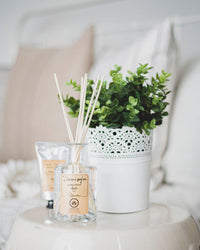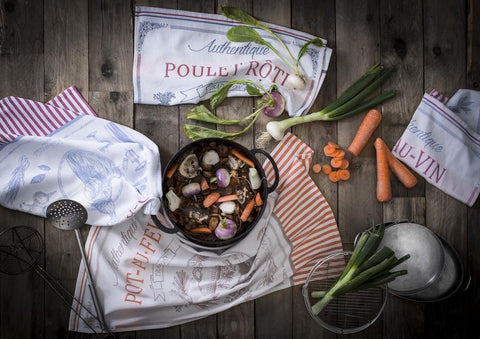Have you ever wondered what put the ‘tea’ into the tea towel? We’re diving into the history of the tea towel then and now. Join us as we explore the evolution of these kitchen staples.
What is a tea towel?
A tea towel is used to clean up spills, dry surfaces, and tidy spaces. But unlike a regular towel or napkin that does the same, tea towels are more durable than a napkin and thinner than a bath towel. They also tend to be much softer. Tea towels are typically made from linen, cotton, or a combination of both.
A tea towel may also be called a dish towel or even a glass towel. A glass towel is ultrasoft in order to, as the name suggests, clean glass without leaving any markings.
But most importantly, tea towels are a much more aesthetic piece than a regular rag. They are woven or printed with designs that are as much decorative as they are functional. A tea towel can become a statement piece in a kitchen by adding a touch of personality or style.
Where did the ‘tea’ in tea towel come from?
While towels or rags have been used in some form to wipe surfaces or dry dishes around the world, tea towels themselves became a symbol of status in Victorian England during the 18th century. As access to textiles increased across the nation, linen became a popular fabric in upper class households to dry crystal and fine China dishes. Linen, a fabric derived from linseed plants, prevented dishes and cups from being scratched, and kept them lint-free.
These tea towels also became an opportunity for a lady to display her creative skills. Women would often hand-embroider their own tea towels, which were then displayed during teatime across a serving tray or wrapped around a hot teapot. These beautiful textiles would then become family heirlooms and be passed down for future generations. You can thrift for an adorable vintage tea towel even today.
The flour sack tea towel
Tea towels also served an equally decorative and functional purpose in America during the 20th century. During the Great Depression, many families repurposed their flower sacks into tea towels by cutting them up into strips.

Flour makers quickly noticed this trend and began to create their own unique designs on their flour sacks. Thus began a new desire for printed tea towels. This new technique is still in use today as printed tea towels remain extremely popular especially for custom gifts.
Tea towels today
Tea towels continue to be popular both for their design and versatility. Did you know Vincent Van Gogh created several paintings on tea towels when he ran out of canvas? In fact, a painting of flowers Van Gogh created on a red and white striped tea towel sold for millions of dollars today. Talk about versatile!
While we each have an individual preference for cotton or linen tea towels, there’s no doubt the tea towel is an essential staple for any kitchen. Plus, when your tea towel is at the end of its life cycle, you can cut the towel up to use as a rag for cleaning the grimier parts of the house. Nothing says eco-friendly like reusing a beloved design for many years.
What kind of tea towel do you prefer? We’d love to hear from you.

